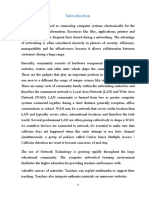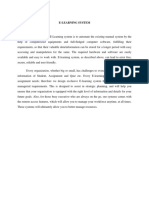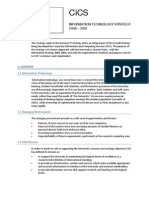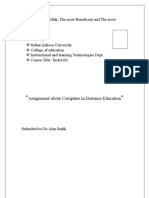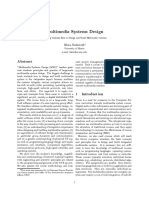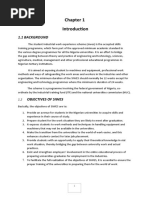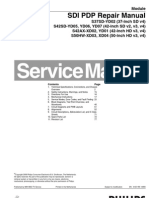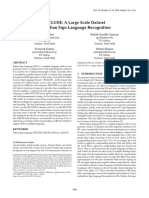Information Systems Infrastructure and Equipment
Information Systems Infrastructure and Equipment
Uploaded by
Praveen NaiduCopyright:
Available Formats
Information Systems Infrastructure and Equipment
Information Systems Infrastructure and Equipment
Uploaded by
Praveen NaiduOriginal Title
Copyright
Available Formats
Share this document
Did you find this document useful?
Is this content inappropriate?
Copyright:
Available Formats
Information Systems Infrastructure and Equipment
Information Systems Infrastructure and Equipment
Uploaded by
Praveen NaiduCopyright:
Available Formats
3.
INFORMATION SYSTEMS INFRASTRUCTURE AND EQUIPMENT Additional instructional computer servers and related equipment must be purchased and maintained to insure the success of this project. This equipment is required beyond what is needed for the normal university Web activity, and must be in addition to the instructional servers presently available. Goal 3A. Instructional computer servers and related equipment will be purchased, implemented, and maintained to insure that the university computing infrastructure is capable of supporting the 99 additional distance education courses developed as a part of this project. Infrastructure and Equipment The following outline summarizes areas in which the OSU Department of Information Services contributed, or invested time or resources, to the Distance and Continuing Education effort at Oregon State University over the period of the project report. Local Workgroup Support. This project provided direct hardware and software support to the course development team members and their manager(s). Workgroup support was a vital function necessary to the successful operation of the workgroup. At the present time the combined workgroups (DCE and IS/CMC) currently operate approximately 30 workstations, including Macintoshes, PC desktops, NT workstations, and several UNIX workstations. Productivity software in use on these machines ranges from the standard Microsoft Office and Outlook Email software, from software used for graphic design, to advanced multimedia authoring suites, as well as digital video editing software to name a few. The workgroup support team has provided the needed maintenance to insure the development and delivery of the proposed 99 distance education courses as a part of this project. Faculty Development Support & Training. While some faculty members take advantage of the talents of the entire course production team, many, if not the majority, choose to pursue the development, production and delivery of their course materials on their own. This often leads to one-on-one consultations and tutorials, on an as-needed, when-needed, basis as they encounter difficulties or roadblocks while pursuing their individual efforts. The DCE course development team members have spent a considerable amount of time providing faculty, (and their student helpers) with these types of consultations. DCE estimates that this time amounts to approximately 20% of course development staff time. Often contact is initiated by telephone or by e-mail. In many cases problem resolution can and does occur using these communication modes as well. DCE staff has also provided training, support and assistance for courses in the CourseInfo course management system. Project staff has also participated as presenters in workshops for faculty, and as tutors to other staff when asked, creating tutorials,
or instructional documentation, or developing course supplementary materials as needed by instructors. Systems Design. Project staff was instrumental in developing the engineering specifications for the current implementation of the central web infrastructure. This design anticipated the growth of the web system in response to a variety of factors, one of the main ones being the anticipated growth of Distance and Continuing Education project over the period of time covered by the Congressionally Directed Grant. Project staff also developed and implemented emerging technologies in distance education course delivery including the use of databases, streaming media, and the use of course management software packages (e.g., CourseInfo). These specifications also took into consideration the anticipated growth in the use of the central web systems not only by the distance students, but by prospective students, resident students, and by other non-traditional students (alumni, extension, etc.). Additional resources were allocated to allow for the growth of non-instructional uses for the infrastructure, including student services and support for distributed instruction to resident/oncampus students. Systems Implementation. The basic systems supported by this project consists of two Sun Enterprise 450 multiprocessor servers, an Enterprise 450 and several Sun SPARC 20s. These servers are currently housed in the machine room of the University Computing Center located in Milne Hall. During the summer months of 1999 project staff tested and implemented prototypes of the proposed configuration on the existing and test servers. The compiling and building a variety of software packages also took place during this period. This was in preparation for the integration of the new systems into the production and delivery environment. Systems Integration. During Fall 1999, the new systems were brought on-line, and the cluster was placed in service in December 1999. This process involved the migration of all user files and data, and adjusting configuration parameters. Systems Maintenance. Maintenance activities are an ongoing responsibility of the project support staff, from user support like resetting passwords, to software upgrades. The amount of activity required for these tasks varies, depending on numerous factors, however the load generally increases to a full workload (1.0 FTE) during the term breaks. During these times when most classes are not in session activities are oriented toward the system level maintenance procedures that would cause unacceptable downtime during the academic terms. Product Support. The largest support task by project staff is CourseInfo, the course development and management software. Instructors choosing not to use CourseInfo and proceed with independent development are allowed access to
the Central Web infrastructure, given a course directory and allowed to develop their own web course sites. The growth in web usage is rather phenomenal and this growth is equally distributed across the spectrum of our users, as well as across the applications, or information being served, from registration and catalog information, i.e. student services, to the growth in the use of the Internet for instructional applications. Streaming Media. The field of streaming media has been evolving during this reporting period. Although still considered a maturing technology, streaming media offers a lot of promise for the instructional arena. The Communication Media Center/Distance & Continuing Education has been experimenting with streaming video over this reporting period using Real Media software. The experimentation has not only given DCE and IS/CMC personnel the opportunity to become familiar with the technology but has also provided the opportunity to explore uses for the technology. Appropriate applications are those where a video will enhance the message being delivered and a great deal of visual acuity is not required. Any place a message needs to be conveyed by audio or video, we are finding that steaming video can play a role. The strength of streaming video is that it is a fairly ubiquitous medium available 24 hours a day seven days a week with wide boundaries. Streaming video requires a large pipeline (i.e., bandwidth) for data to flow and enough processing power on the users end to convert the compressed data to video. The primary deterrent to the use of streaming video has been the need for more robust networks and for a large base of personal computers with the capability of processing the video. To some extent both have arrived. Computers costing as little as a thousand dollars can now handle the processing requirements of streaming media. Surveys of potential clients/students show that a majority of students now own computers with the capacity to handle streaming video. The Communication Media Center and DCE has identified several uses for streaming media. One is the use of video clips in distance education Web delivered courses and as supplemental information to campus courses. In both cases it provides an alternate mode by which to communicate information. Some courses are already transmitted and recorded as part of distributed education interactive video courses. Only one more step is needed to archive the video for later use for studying or making up missed classes. Our findings are beginning to show that streaming media is a technology that may improve the learning process. The mission of the streaming media server is to support the entire OSU community, with Distance & Continuing Education (DCE) as the major customer and client for the service. The streaming media initiative has been a targeted part of this project to support on-line delivery of instructional content for both
main-campus and distance courses, as well as support of institutional communication needs, including extension offices located around Oregon. For the period Dec. 1st to June 30th 2000. DCE lead the design and implementation of the current video streaming infrastructure. This included the responsibility for the following: the creation of the overall streaming infrastructure design participating in current and future central internet systems design work equipment specification purchasing proposals and equipment purchase equipment set-up, installation, and configuration working with Network Engineering to troubleshoot existing multicasting infrastructure creation of OSU media streaming policies the production of streaming exemplars the creation of the temporary media Website streaming systems administration media database design infrastructure roll-out the upgrade path, how to design of Phase II and III of the system
As of June 30th, 2000, Phase I of the infrastructure was installed, a very basic temporary Website had been created (http://instruct.orst.edu/smi), and several examples of streaming media were on-line. Plans were being made pertaining to: system roll-out media production processes introduction of the OSU community to the streaming services what is the next step for the streaming project, what are the main technical and human issues, and what needs to be folded into Phase II?
DCE expects steady growth of traffic and interest in the service through the summer of 2000, into the fall of 2001. Beginning fall 2001, we expect to be streaming media for courses, both on and off the main OSU campus. Recommendations for the 2000-2001 year include: a redesign of the media database, as the original design was flawed installation of Phase II of the media infrastructure, which will allow more robust delivery of media with fewer interruptions, a larger server space on which to store media, and the ability to encode more classes and events at OSU policies concerning media copyright and project funding need to be revisited
media streaming for OSU should be centralized in IS/DCE QuickTime streaming needs to be evaluated as a possible streaming technology to compliment the current RealNetworks system automation for live Webcasting of current video-delivery classes need to be added to Phase II more robust support for the RealPlayer client needs to be implemented media streaming consultation and needs to be provided for faculty and staff doing institutional and course Website production the main streaming media Website needs to be designed and created.
Interactive Television. The Communication Media Center, through telecommunications systems, provides distance delivery of live classes to remote locations in the state and elsewhere in the country. Four classrooms have been designed specifically for this purpose. The CMC television studio can support live teleconference origination and up link via satellite. CMC will assist production of domestic and international teleconference events. PictureTel, also available at CMC, is a digital video conferencing system that allows users to hold a video meeting worldwide with any compatible system. In Oregon all OUS institutions are networked with PictureTel units, enabling users to schedule meetings with one school or the whole Oregon State System of Higher Education. CMC also has satellite downlink receiving equipment for teleconferencing and receiving instructional programs. CMC produces satellite teleconferences for OSU departments, and for state and national distribution. CMC provides technical support and course development assistance for delivery over Oregon Ed-Net and other telecommunication systems. Provides faculty and staff support with instructional design of OSU curriculum for teaching, research and extension via distance education technologies. Provides faculty and staff with consultation on different types of distance education technologies that allow them to reach audiences and receive programming from other institutions in Oregon, outside of Oregon and the world. Prepares faculty and support staff by assisting and designing their traditional courses to be presented on an interactive television distance education network or Internet and WEB based courses. Prepares faculty and staff support in developing and producing a special event teleconferences(s) for non-credit class(es). Develops and teaches workshops in equipped facilities on distance education methods and technology. Workshops range from 2 hours to 4 days.
Provides continuing feedback or critiques to faculty as they participate in distance education classes and special event teleconferences. Schedules and coordinates the appropriate technology needed to either send or receive a distance education class or teleconferences. Schedules receive and origination sites for distance education programming with sites in Oregon, out-of-state and worldwide. Schedules and coordinates with faculty the specially equipped television classrooms and other teleconferencing rooms on the OSU campus. Schedules additional audio-visual and multimedia technologies to be used. Schedules satellite downlinks to record and distribute programs off satellite that supports and enhances instruction, professional development for OSU faculty, students and staff. Schedules and playback of instructional television programming on Corvallis cable television channel 18. Supports faculty productivity and student access by videotaping courses for delayed multiple broadcasts on cable systems in Corvallis and throughout Oregon. Hires student television technicians and trains them for hands-on experience operating video production equipment when producing distance education classes. Faculty members are not responsible for technical switching. Distributes videotapes of synchronous and asynchronous distance education courses on campus and to Distance & Continuing Education students and cable television providers. Collaborates with other Information Services groups and other campus media departments on distance education programs. Assists faculty in videotape editing segments for their courses and teleconferences. Works with faculty in editing selected distance education television courses for future courses. Provides faculty with television remote production support for shooting and editing videotape segments to be used in their distance education class.
Assures OSU currency in new technologies for both asynchronous and interactive video instruction. Researches and tracks state of the art technologies. Assists faculty in seeking copyright clearance materials for use in distance education classes and teleconferences. In coordination with the Distance Education Librarian, provides orientation and information to faculty about OSU library access and services designed specifically for distance learners. Facilitates delivery (by The Valley Library staff) of orientation and instruction to students about doing library research as distance learners via DAD OnLine Service formally Oregon Ed-Net or other delivery methods used for classes. Communicates with Distance Education Librarian about new program and sites in order to facility timely service arrangements (both internal and external to OSU) for library support to OSU distance learners. CMC makes arrangements with Community College libraries and/or media centers for placements of videotapes of OSU courses in process for the use of students in those courses.
You might also like
- Project Concept: F L S S RDocument9 pagesProject Concept: F L S S RmrkssastryNo ratings yet
- 'Chapter One 1.1 Background of The StudyDocument48 pages'Chapter One 1.1 Background of The StudyjethroNo ratings yet
- Final Project 1Document76 pagesFinal Project 1محمد فوزي الورفليNo ratings yet
- Flex BasedDocument102 pagesFlex Basedvinay999100% (1)
- Thomas Hoover Resume 072314Document6 pagesThomas Hoover Resume 072314Khalid AhmedNo ratings yet
- Design and Implementation of A Departmental PortalDocument10 pagesDesign and Implementation of A Departmental Portalelijahemmanuel05No ratings yet
- Strategic PlanDocument13 pagesStrategic PlanrafayelNo ratings yet
- DanielDocument67 pagesDanielMercy EmmansonNo ratings yet
- KinpllusDocument23 pagesKinpllusOwoeye ShinaNo ratings yet
- Chapter One General Description of The Organization Back Ground of The CompanyDocument44 pagesChapter One General Description of The Organization Back Ground of The CompanyHus Forth CorrentyNo ratings yet
- A Grid-Based E-Learning Model For Open UniversitiesDocument4 pagesA Grid-Based E-Learning Model For Open UniversitiesmouhabaldeNo ratings yet
- VPIT Status and Activity Report For May 2020Document5 pagesVPIT Status and Activity Report For May 2020accidentalcioNo ratings yet
- Offline Content Player Framework: Pratiksha Chavan, Bebi Anande, Swapnali JadhavDocument3 pagesOffline Content Player Framework: Pratiksha Chavan, Bebi Anande, Swapnali JadhavtheijesNo ratings yet
- 15Document8 pages15ProjectLANo ratings yet
- Campus Information System PDFDocument63 pagesCampus Information System PDFBrian FoxNo ratings yet
- Chapter 7Document5 pagesChapter 7Omkar Pradeep KhanvilkarNo ratings yet
- Technology Program Administrator Final3Document14 pagesTechnology Program Administrator Final3scottmpriceNo ratings yet
- Online Student Clearance System Case Study (Cur)Document10 pagesOnline Student Clearance System Case Study (Cur)Osama TariqNo ratings yet
- Siwes ReportDocument14 pagesSiwes ReportADIGUN GodwinNo ratings yet
- Siwes RDocument52 pagesSiwes RDr Mo EntertainmentNo ratings yet
- School Evaluation SummaryDocument12 pagesSchool Evaluation SummaryBob ThompsonNo ratings yet
- Grid Final ReportDocument15 pagesGrid Final ReportSaloni BansalNo ratings yet
- Cloud Computing Based E-Learning SystemDocument8 pagesCloud Computing Based E-Learning Systemannaicsdepartment100% (2)
- Issues and Strategies of E-LearningDocument9 pagesIssues and Strategies of E-LearningSunway University100% (2)
- Technology Program Administrator Final3Document14 pagesTechnology Program Administrator Final3scottmpriceNo ratings yet
- Untitled PresentationDocument11 pagesUntitled Presentationjahnabordoloi14No ratings yet
- The Comparison of Learning Analytics Tools Which Are Used in Learning Management Systems (LMS) IDocument11 pagesThe Comparison of Learning Analytics Tools Which Are Used in Learning Management Systems (LMS) Ia10b11No ratings yet
- serchingDocument17 pagesserchingdeepdeepdeep568No ratings yet
- Gradudation_Project_Ideas_Spring_2015Document27 pagesGradudation_Project_Ideas_Spring_2015ahmad.hassan20755No ratings yet
- EDU 623 Final ProjectDocument17 pagesEDU 623 Final ProjectMax McGeeNo ratings yet
- E-Learning SystemDocument35 pagesE-Learning SystemEminent ProjectsNo ratings yet
- Hune Gedam 009-1Document36 pagesHune Gedam 009-1Hus Forth CorrentyNo ratings yet
- Development of Online Learning System For Software PDFDocument12 pagesDevelopment of Online Learning System For Software PDFRafy AlahmadNo ratings yet
- The Design and Development of Advanced Network Services Over The Patras University Campus NetworkDocument8 pagesThe Design and Development of Advanced Network Services Over The Patras University Campus NetworkOluwafemi Samuel AdesanmiNo ratings yet
- Emello Ed7814 U01a1Document7 pagesEmello Ed7814 U01a1api-311214051No ratings yet
- Lab Activity 1 Evaluating Interface Design Using Ben Shneiderman's 8 Rules in A Laboratory SettingDocument18 pagesLab Activity 1 Evaluating Interface Design Using Ben Shneiderman's 8 Rules in A Laboratory SettingFARNo ratings yet
- Project Title: Ambo University Woliso Campus School of Technology and InformaticsDocument5 pagesProject Title: Ambo University Woliso Campus School of Technology and InformaticsDagim Fekadu Amenu100% (1)
- STUDENT INFORMATION SYSTEM Proposal-PD-NUR FATIHAH BINTI ZUAZNIDocument8 pagesSTUDENT INFORMATION SYSTEM Proposal-PD-NUR FATIHAH BINTI ZUAZNItyaaNo ratings yet
- Cics It StrategyDocument7 pagesCics It StrategyelmahieNo ratings yet
- Chapter OneDocument6 pagesChapter OneTobiloba TemitopeNo ratings yet
- World Education Award 2011 JMI-EntryDocument8 pagesWorld Education Award 2011 JMI-EntryS.Kazim NaqviNo ratings yet
- Elearning 2012Document25 pagesElearning 2012Babu RaoNo ratings yet
- VADEMECUM E-Solutions For Remote Activities FINAL 25 March PDFDocument6 pagesVADEMECUM E-Solutions For Remote Activities FINAL 25 March PDFVladislav RaileanNo ratings yet
- Distance Education at A GlanceretDocument4 pagesDistance Education at A GlanceretMohammed RashidNo ratings yet
- Online E-Learning Portal System Synopsis - RemovedDocument6 pagesOnline E-Learning Portal System Synopsis - RemovedSanjay H MNo ratings yet
- Multimedia Systems DesignDocument8 pagesMultimedia Systems DesignBardhyl BejtullahuNo ratings yet
- Clearance NEWDocument38 pagesClearance NEWAfenifere Yusuff YoungproffNo ratings yet
- Application Introduction LatestDocument6 pagesApplication Introduction Latestfrancissamuel929No ratings yet
- Industrial Training Report 1Document48 pagesIndustrial Training Report 1Mia NiveriaNo ratings yet
- Chapter 1Document21 pagesChapter 1Lanre AyanwaleNo ratings yet
- Center For Academic Technology Support Evaluation: Snead "CATS Eval" 1Document6 pagesCenter For Academic Technology Support Evaluation: Snead "CATS Eval" 1msnead6867No ratings yet
- Final Project-WPS OfficeDocument35 pagesFinal Project-WPS OfficeSami MakNo ratings yet
- Chapter IVDocument12 pagesChapter IVJo BltzarNo ratings yet
- Alumni Project Report IIDocument86 pagesAlumni Project Report IIimranger001No ratings yet
- Final Report - Personal Learning Environments and Personal Development PlanningDocument5 pagesFinal Report - Personal Learning Environments and Personal Development PlanningAJCann100% (1)
- Edem CSC ReportDocument28 pagesEdem CSC ReportErhueh Kester AghoghoNo ratings yet
- Shuwahib Internship Report: Chapter OneDocument57 pagesShuwahib Internship Report: Chapter OneAbdulkerim100% (1)
- Ict Strategic PlanningDocument9 pagesIct Strategic Planningfeezy11No ratings yet
- Information Technology Strategy: Supporting ExcellenceDocument20 pagesInformation Technology Strategy: Supporting ExcellenceMary Grace LimNo ratings yet
- Institutional Literacies: Engaging Academic IT Contexts for Writing and CommunicationFrom EverandInstitutional Literacies: Engaging Academic IT Contexts for Writing and CommunicationNo ratings yet
- ATM Terminal Design Based On Figure Print Recognition DocuDocument115 pagesATM Terminal Design Based On Figure Print Recognition DocuPraveen NaiduNo ratings yet
- Plastic Lever PumpDocument1 pagePlastic Lever PumpPraveen NaiduNo ratings yet
- Tta PDF NimirajDocument16 pagesTta PDF NimirajDhaneswar MajhiNo ratings yet
- Networking HardwareDocument9 pagesNetworking HardwarePraveen NaiduNo ratings yet
- Datasheet of DS 9632NI M8 - V4.63.010 - 20230705Document5 pagesDatasheet of DS 9632NI M8 - V4.63.010 - 20230705Bernando NoviannNo ratings yet
- FLIR Recon V: Thermal Binocular With Eo, Laser Rangefinder, and Laser PointerDocument2 pagesFLIR Recon V: Thermal Binocular With Eo, Laser Rangefinder, and Laser PointerNz225No ratings yet
- KN40507 Manual ENDocument9 pagesKN40507 Manual ENAEC SOLUTIONSNo ratings yet
- TraceDocument75 pagesTraceJhonatan cardosoNo ratings yet
- Aoc A27w231Document65 pagesAoc A27w231Andy Do100% (2)
- Audio Visual TranslationDocument7 pagesAudio Visual TranslationAna Mihaljuk100% (1)
- UN46ES6150: Product HighlightsDocument3 pagesUN46ES6150: Product HighlightsExternos y no externos HD Calidad En ReproducciónNo ratings yet
- InstantEye MK 3 GEN5 1.1Document4 pagesInstantEye MK 3 GEN5 1.1nat-tamail.ruNo ratings yet
- MODEL: T.MS6M181.7X (Asia) : Part Number: MST-10120903Document11 pagesMODEL: T.MS6M181.7X (Asia) : Part Number: MST-10120903Ion PetruscaNo ratings yet
- ltw32 42dvDocument44 pagesltw32 42dvMaria de GuerreroNo ratings yet
- Colour TelevisionDocument77 pagesColour Televisionfaroltek100% (2)
- Chapter 2Document66 pagesChapter 2Sewunet SamuelNo ratings yet
- CV3393BH B 10 Specification V1.0Document16 pagesCV3393BH B 10 Specification V1.0Красимир КостадиновNo ratings yet
- Philips 26 Widescreen Flat TV 26pf4310 10 Manual de UsuarioDocument3 pagesPhilips 26 Widescreen Flat TV 26pf4310 10 Manual de UsuarioFernan AikaNo ratings yet
- Q2 - Module 5 - For StudentsDocument21 pagesQ2 - Module 5 - For StudentsmarkjohnmagcalengNo ratings yet
- Sridhar 2020Document10 pagesSridhar 2020coconutchorNo ratings yet
- Mini ProjectDocument13 pagesMini Projectbabblubabblu295No ratings yet
- XTS-DVR72 XX-V Versatile Series: Downloaded From Manuals Search EngineDocument137 pagesXTS-DVR72 XX-V Versatile Series: Downloaded From Manuals Search EnginermsercomNo ratings yet
- 2 IPTV AsllaDocument2,248 pages2 IPTV AsllaFitimHaliliNo ratings yet
- MPEG-4 AVC (H.264) Ad Insertion Solution: White Paper Revision 1.0 July 2007Document10 pagesMPEG-4 AVC (H.264) Ad Insertion Solution: White Paper Revision 1.0 July 2007Hanns JorgNo ratings yet
- The Pussycat Dolls - Bottle PopDocument2 pagesThe Pussycat Dolls - Bottle PopkampacNo ratings yet
- Python Screen Recorder - Python GeeksDocument1 pagePython Screen Recorder - Python Geeksrogersalex294No ratings yet
- MANUAL EDISION Nano T265+ ENDocument28 pagesMANUAL EDISION Nano T265+ ENmancheno.aliciaNo ratings yet
- NetSDK - C# Programming Manual (Intelligent Event)Document78 pagesNetSDK - C# Programming Manual (Intelligent Event)Sup San VicNo ratings yet
- Precios Glexim 09-09-2011Document19 pagesPrecios Glexim 09-09-2011Jx Let's RockNo ratings yet
- Copperhead Pro Users Guide 111118vf1Document74 pagesCopperhead Pro Users Guide 111118vf1papahoggyNo ratings yet
- A Proposed Classification of ICT Goods - OCDE2003Document13 pagesA Proposed Classification of ICT Goods - OCDE2003Mohamed BenabdelkaderNo ratings yet
- Flatron w1943sbDocument32 pagesFlatron w1943sbLuis ArévaloNo ratings yet
- Sony VHS SLV 610 710Document86 pagesSony VHS SLV 610 710StefanoViganó100% (1)
- Company Profile: A. VisionDocument3 pagesCompany Profile: A. Visionrizky akbarNo ratings yet


